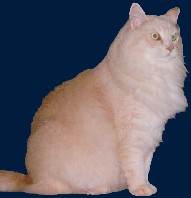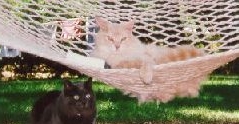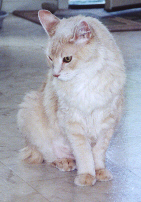 Barney's Story: The Sweet Life of a Diabetic Cat
Barney's Story: The Sweet Life of a Diabetic Cat
 Barney's Story: The Sweet Life of a Diabetic Cat
Barney's Story: The Sweet Life of a Diabetic Cat |
|
|
Barney
 is a neutered male cat. When he was 14 years
old, we noticed several changes in his behavior. He was drinking,
urinating, and eating a lot, vomiting his meals occasionally, and he had
lost a little weight. Barney was also having a hard time climbing stairs,
jumping on the bed, or getting on the couch. For a cat who loves to sit in
your lap, not being able to jump onto the couch and into your lap is a
very sad sight. is a neutered male cat. When he was 14 years
old, we noticed several changes in his behavior. He was drinking,
urinating, and eating a lot, vomiting his meals occasionally, and he had
lost a little weight. Barney was also having a hard time climbing stairs,
jumping on the bed, or getting on the couch. For a cat who loves to sit in
your lap, not being able to jump onto the couch and into your lap is a
very sad sight.We thought Barney was just getting old and his health was starting a natural decline. We assumed his decreased mobility was due to arthritis, but since so many things were changing with Barney, we decided it was best to take him in to the vet for a check-up. He was diagnosed with diabetes in March, 1997. Barney was put on a prescription diet (Hills w/d) and started getting insulin injections. He tolerated the injections very well, but the change in diet was another story. Barney hated the dry w/d and refused to eat it. We decided the Hills Science Diet feline light he was use to eating was a fairly healthy alternative, so we continued with that food for a while. After Barney was feeling better, we gradually started replacing some of his light dry food with the w/d dry food. This took several weeks, but we got him switched over to eating all w/d. During the first  few
months of treatment Barney showed slow but steady improvement. He stopped
drinking and urinating so much, he gained back the weight he had lost, and
his strength returned. We had our Barney back and there was no stopping
him. He was now jumping on the bed, couch, table - he even started
climbing trees again. He dominated the other animals in the house,
including his best friend Bogey, a 50-pound Border Collie. few
months of treatment Barney showed slow but steady improvement. He stopped
drinking and urinating so much, he gained back the weight he had lost, and
his strength returned. We had our Barney back and there was no stopping
him. He was now jumping on the bed, couch, table - he even started
climbing trees again. He dominated the other animals in the house,
including his best friend Bogey, a 50-pound Border Collie.It has sometimes been difficult to keep Barney's diabetes under control. At first, we were using urine glucose test strips to monitor Barney's diabetes. But these tests didn't provide us with the information we needed to control his diabetes. Also, Barney becomes highly stressed when the vet tries to obtain a blood sample and the stress results in elevated bgs, so the numbers the vet gets are not representative of Barney's normal daily blood glucose. So we started home blood glucose monitoring. Barney's vet agrees that home blood glucose testing is the best method for monitoring Barney's diabetes. We perform the tests at home and call the vet to tell him the numbers and get advice. In  the first 18 months of his diabetes, Barney was on four different types of
insulin (Humulin NPH, Humulin Ultralente, Beef/pork Lente, and finally
PZI). The NPH and Lente did not have a long enough duration for Barney,
and the Ultralente had a highly irregular effect on his bgs (sometimes it
worked, sometimes it didn't). This is not an unusual response for cats to
ultralente insulin. For the past 2-1/2 years, we have been using PZI
(protamine zinc insulin), which can be obtained from several specialty
veterinary pharmaceutical sources.
the first 18 months of his diabetes, Barney was on four different types of
insulin (Humulin NPH, Humulin Ultralente, Beef/pork Lente, and finally
PZI). The NPH and Lente did not have a long enough duration for Barney,
and the Ultralente had a highly irregular effect on his bgs (sometimes it
worked, sometimes it didn't). This is not an unusual response for cats to
ultralente insulin. For the past 2-1/2 years, we have been using PZI
(protamine zinc insulin), which can be obtained from several specialty
veterinary pharmaceutical sources.We use a lot of daily observation to help determine if Barney is healthy. We keep an eye on the size of the urine clumps in his litter box, watch to see if his drinking increases, watch for weight loss, or any other signs that his diabetes is uncontrolled. We watch his behavior too. If he seems too sleepy, has no energy, or just seems to be "out of sorts" we do some blood glucose testing to determine if his insulin dose needs to be adjusted. For the past several years, Barney's diabetes has been managed using two shots of insulin each day, one in the morning and one in the evening. His diet is mostly Hills w/d kibble and canned. We have him on a semi-controlled feeding plan where he gets his canned food along with his insulin injection and is allowed to free-feed on kibble at other times. He also gets other high quality canned food to encourage him to eat at the appropriate times. Barney is also on tapezole, a medication for an overactive thyroid. His thyroid medication is hidden in a small piece of cheese which he gets after his insulin. Barney looks forward to getting his insulin shot because he knows it is followed by some yummy cheese. Our management style of observation, a semi-controlled diet, twice daily insulin injections, occasional home blood glucose testing, and necessary trips to the vet have worked well for us to control Barney's diabetes. In June 2000  ,
Barney went in for a regular checkup. During the exam, his vet felt
something unusual in his abdomen. After X-rays and ultrasound, it was
determined that Barney had a very large tumor that involved his liver. The
vets weren't sure how the tumor was attached to the liver or how much of
the liver was involved -- they would only be able to determine that during
surgery. We were faced with lots of "what ifs" in terms of the
type of tumor this could be, how much of the liver was involved, the risks
of surgery, and the prognosis. After lots of discussion with his vet, we
decided Barney would have the surgery. He was a strong kitty and his
diabetes was not an issue. The operation went very well, and the surgeon
thought they were able to remove all of the tumor. Part of his liver and
his gall bladder were also removed. Unfortunately, there were some
abnormal looking spots on the remaining portion of his liver, but the vet
wasn't sure if they were cancerous or not. Pathology reports on the tumor
showed that Barney has a severe form of liver cancer that involves the
bile ducts. After more consultations between the oncologist, pathologist,
and his regular vet, it was decided that the chemotherapy drug used to try
to treat this cancer has a lot of serious side effects and would not be in
Barney's best interest. Hopefully the cancer would be slow to return. ,
Barney went in for a regular checkup. During the exam, his vet felt
something unusual in his abdomen. After X-rays and ultrasound, it was
determined that Barney had a very large tumor that involved his liver. The
vets weren't sure how the tumor was attached to the liver or how much of
the liver was involved -- they would only be able to determine that during
surgery. We were faced with lots of "what ifs" in terms of the
type of tumor this could be, how much of the liver was involved, the risks
of surgery, and the prognosis. After lots of discussion with his vet, we
decided Barney would have the surgery. He was a strong kitty and his
diabetes was not an issue. The operation went very well, and the surgeon
thought they were able to remove all of the tumor. Part of his liver and
his gall bladder were also removed. Unfortunately, there were some
abnormal looking spots on the remaining portion of his liver, but the vet
wasn't sure if they were cancerous or not. Pathology reports on the tumor
showed that Barney has a severe form of liver cancer that involves the
bile ducts. After more consultations between the oncologist, pathologist,
and his regular vet, it was decided that the chemotherapy drug used to try
to treat this cancer has a lot of serious side effects and would not be in
Barney's best interest. Hopefully the cancer would be slow to return.March 2001 -- we made it to four years as a diabetic!!! This anniversary is bitter-sweet for us because the liver cancer has progressed and Barney's health has declined. His appetite comes and goes and he has bouts of vomiting. He receives very small doses of insulin now - just to keep his bg from going extremely high. He still enjoys laying in the sun, being petted, and purrrrring. We're keeping him comfortable and letting his attitude and behavior guide our decisions. March 23, 2001. After a few alternating good and not-so-good weeks, Barney is ready to leave us. He is not comfortable and doesn't want to do any of the things that give him pleasure - like going outside to lay in the sun. His wonderful vet who has cared for him for the past 4 years came to the house to put him to sleep where Barney could be relaxed and calm. When we learned Barney was diabetic, we began to form an even stronger bond with him. We learned we could no longer take his presence for granted and it taught us to appreciate each and every day that we share with each of our pets. Barney had a fantastic life - 17 years of generally good health, a family, and love. We'll remember him for the wonderful kitty he was. Please remember your pets - those who have passed away, and those that are still here - for the wonderful souls they are and the happiness you share with them. I hope our experiences with Barney show that a pet who has diabetes can live a healthy, happy life. For four years we managed to keep the diabetes pretty well controlled. At age 17, it wasn't diabetes that was the problem, but an aggressive and untreatable liver cancer. Until the end, Barney was active, strong, playful, happy, and a joy to be with. Successful diabetes management requires commitment, hard work, education, and a partnership with a great vet. But it can be done. Barney is proof.
Updated March 2001 |